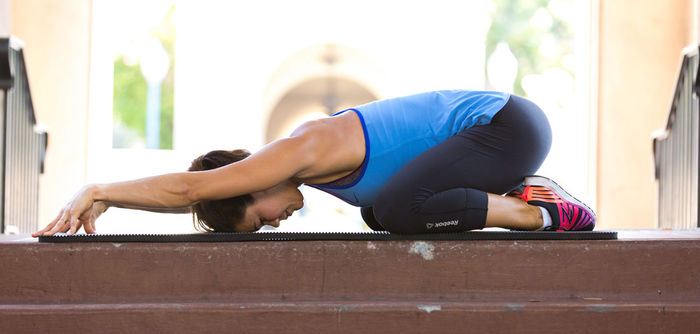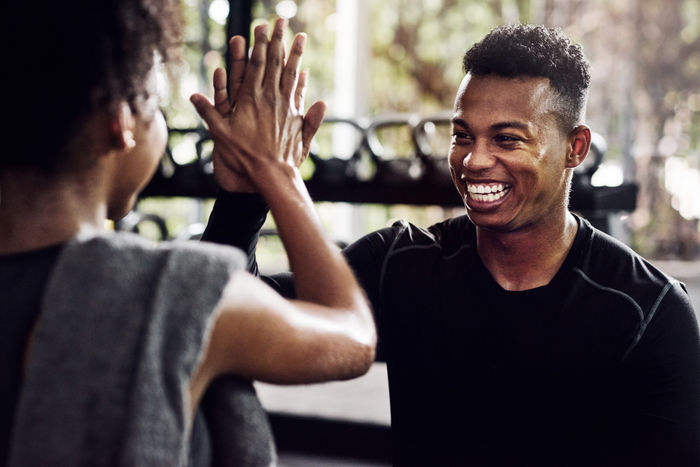“The future is always beginning now” – Marc Strand, poet
Seated workouts are a great option for clients who have mobility issues, such as the elderly or those with obesity. This is because sitting down eliminates the risk of falling and the need for standing strength when performing beginning strength, cardio and flexibility training. Here are five considerations for using seated workouts with your clients, and some starting exercises that could help pave the way for standing workouts in the future.
1. Welcome Clients Where They Are
Trainers are often told to meet clients where they are skills-wise. Deconditioned clients are often scared or intimidated by their perceived or real lack of abilities, so meeting them might not be enough. Extra warmth and welcome, however, can go a long way toward making them feel more comfortable. Though false praise doesn’t help anyone, make sure to scale your encouragement to the level of effort made, not to the difficulty of the task given. Be sure to practice kind and direct communication with your clients, which will foster supportive and trusting relationships.
2. Summon Strength
For elderly clients, strength training can dramatically improve the ability to perform activities of daily living, which in turn fosters an independent lifestyle. For clients with obesity, strength training can help build calorie-burning lean muscle, which aids in weight-loss. While a full-body strength seated workout is possible, working the gluteus and quadriceps muscles is a key starting point, as these large muscle groups have the potential to burn lots of calories and are essential to basic movements including sitting, standing and walking without assistance.
For the following exercises, have clients begin sitting near the edge of the seat, facing forward and with both feet on the floor. Remind them to maintain good posture throughout the movements. (Note: Always use a straight-backed chair without wheels or arms.)
Leg Lift
Straighten one knee until the leg is parallel with the floor, and then return to the starting position. Alternate legs and repeat. This exercise can be progressed by holding the leg out straight or by elevating the leg slightly in the straightened position.
Squat
Sit near the edge of the chair seat, and without using arms, slowly come to a standing position. Sit back down again and repeat. This exercise can be progressed by slowing down the movement or holding the squat position over the chair.
Glute Squeeze
Squeeze the buttocks muscles together, hold a few seconds and then release and repeat. To increase intensity, hold the squeeze for longer period of time.
3. Find Flexibility
In addition to enhanced blood flow and stress relief, stretching helps address the natural shortening and loss of elasticity or muscles that occurs with age and can cause pain and decreased range of motion. Here are three stretches designed to address the back and shoulders—frequent places for the aches and pains show up in both the elderly and individuals with obesity.
For these exercises, have clients begin sitting near the edge of the seat, facing forward and with both feet on the floor. Remind them to maintain good posture throughout the movements and hold each stretch for at least 30 seconds.
Shoulder and Upper-back Reach
Start with the elbows bent and the palms pressed together in front of the chest (prayer position). Extend the arms overhead in a “v” position with palms facing forward (exhale), reaching as far as possible. Return the arms to prayer position and squeeze the shoulder blades back and down (inhale).
Shoulder Roll
Start in a neutral position with the hands resting on the thighs. Raise the shoulders and shoulder blades toward the ears (inhale). Return to the starting position by pressing the shoulders back and together (exhale).
Neck Stretch
Facing forward, tilt the head so that the right ear moves toward the right shoulder. Extend the left arm to the left side. Release and repeat on the other side.
4. Keep Up the Cardio
Getting the heart pumping and oxygen flowing is especially important for sedentary clients. Here are a couple of exercises to kick-start a seated routine, with special attention to the core:
Seated March
From a seated position, lift one knee at a time, as if marching. Raise alternating arms. The back should be straight and the core engaged. This movmeent can be progressed y increasing the tempo and lifting the knees higher.
Seated Jacks
Sit at the edge of the seat with knees together and pointed toes resting lightly on the floor. Bend the arms so that the hands are out to the sides with palms facing forward. In one movement, raise both arms overhead and extend both legs straight out to the sides, flexing the feet with the heels resting lightly on the floor. Return to the starting position and repeat.
Seated Side Skater
Start facing forward with both legs on the floor and arms extended out to the sides. In one movement, extend the right leg out to the side, and reach the right arm toward the left foot—engaging the core as well as the arms and shoulders. Come back to center and switch sides. For additional difficulty, go directly from one side to the opposite side.
5. Cultivate Creativity
As you and your clients become more experienced with seated workouts, get creative. Start incorporating your regular workout equipment, such as weights, resistance bands and stability balls, into the seated workouts. You can develop more advanced aerobic routines, chair dances and seated yoga poses to keep workouts customized and fun with steady progress.
With time, your seated-workout clients will likely move on to more standard exercise. Don’t push anyone unnecessarily quickly, though, when a perfectly good workout is accessible from the safety of a chair.
Furthermore, not only deconditioned clients benefit from seated workouts: these exercises can help maintain fitness through an injury or allow more fit clients to sneak some exercise into a workday. Consider seated workouts as a fun variation that just about anyone can enjoy.
Functional training can help all adults improve movement efficiency. Learn how you can functionally train your clients with ACE’s Functional Training Specialist program.
 by
by 








 by
by